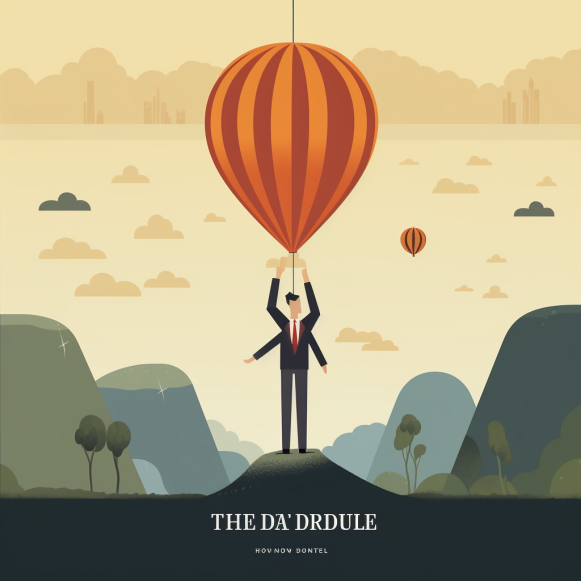How a former Guggenheim banker pivoted to newsletter publishing and built The Daily Upside to profitability in 4 years

- Patrick Trousdale’s The Daily Upside newsletter for investors just hit 1 million subscribers.
- It’s an example of how a media startup can be profitable in a jittery time for the industry.
- The ex-Guggenheim banker plans to launch more newsletters and paid content, as well as get into audio and video.
Patrick Trousdale had the opportunity to observe the media industry up close while working as an investment banker at Guggenheim Partners over the last decade. While he was there, Guggenheim Securities worked on Vice Media, the brash digital-media darling that was once worth billions.
When Trousdale left to launch his own media venture for investors, The Daily Upside, in 2019, he gravitated toward Morning Brew (which now shares an owner with Insider) and The Hustle, both of which had success with modest outside funding.
“You have sizzle before the steak at times with digital media,” Trousdale, 33, told Insider in August. “I’d seen it many times before.” So I knew right away that I didn’t want to raise a lot of money.”
He added, “It was going to take longer” to build the business that way. “However, it was critical to find the right model.”
Since its launch in 2019, The Daily Upside has grown to 1 million subscribers, with a 45% open rate, roughly double the average open rate of media and finance newsletters, according to MailChimp, and profitably (aided by Trousdale foregoing a salary for three years). It made $2.3 million in revenue in 2022, which it expects to increase by at least 50% this year.
While the heyday of venture-backed digital media companies has passed, The Daily Upside is part of a growing class of newsletter-based startups, such as Puck and Graydon Carter’s Air Mail, that are small in size but built to last — by growing slowly, with multiple revenue streams, and content readers can’t get anywhere else. While Trousdale recognizes that people can get their news from a variety of sources, his goal is to provide context that may be lacking in other news reports, as well as “grounded optimism.”
The Daily Upside is expanding and adding original content
With a staff of 18, The Daily Upside has been increasing its original content to supplement its aggregated pieces, with articles such as “The Largest Wealth Transfer in History Has Begun” and “AirbnB is Letting the Air Out.” This year, it acquired Patent Drop, a media company founded by former Protocol writer Nat Rubio-Licht that crawls registries for company patent filings, and launched Power Corridor, a newsletter founded by longtime investigative journalist Leah McGrath Goodman.
Goodman stated that she was looking for her next step when she met Trousdale, and his desire to build something from the ground up and fill a void resonated with her. She described the internal debate over what editorial tone to take.
“I think he felt like there was a lot of cynicism built into financial news,” she explained. “Perhaps a little too much joy in announcing layoffs, too much politics, too much horse-race coverage.” We’ll deliver the news while tempering our cynicism. It’s about appealing to an audience that doesn’t want to spend all day being righteously indignant.”
The Daily Upside required some trial and error. Trousdale wrote the newsletter himself at first, focusing on one company each day, but realized readers needed some connection to the daily news cycle in order to open it.
After a couple of years of slowly growing by word of mouth, he struck swap partnerships with other news outlets, beginning with The Motley Fool; others, including the Financial Times, followed. These partnerships have helped The Daily Upside’s subscriber base grow and attracted sponsorships from companies such as Apple, financial services company Plaid, and Axios. The Motley Fool also made a minor investment in the company.
The Daily Upside’s ability to write about complex topics in plain English, with analysis and wit — and Trousdale’s entrepreneurial thrift — impressed John Keeling, SVP Business Development and venture partner at The Motley Fool.
“He was living on ramen noodles for a long time,” Keeling explained.
Trousdale also used paid collaborations with creators. While The Daily Upside experimented with TikTokers to promote the newsletter, it found greater success reaching out to investment-minded individuals through YouTube personalities such as finance guru Patrick Boyle, whose videos have resulted in The Daily Upside gaining thousands of new subscribers.
“I’d be lying if I said I thought I had the complete bible for what works,” Trousdale admitted. “But for us, staying in our lane with our original product, original idea, and original voice is what has allowed us to stay profitable in a tough market.”
A paid model is in the plans, along with podcasts and video
Trousdale is inspired by Puck and Air Mail, which both use a freemium model and have raised outside funding, despite recent high-profile newsletter swings by Substack and Facebook. He also sees his approach as a way to avoid reliance on the shifting support of tech giants for journalism and to survive the rise of generative AI.
“AI isn’t going to be able to call someone, get an original opinion, or a scoop,” he said.
“When you look at media more broadly, there’s a signal-to-noise problem, with clickbait and media companies writing for SEO and growing at all costs,” Keeling explained. “Not all businesses are meant to be on the scale of Google and Amazon. So there’s a wonderful business model there for those who really build on voice and maintain that quality of audience.”
Trousdale’s next goals include creating a paid version of The Daily Upside’s newsletters, adding more newsletters, and expanding into podcasts and short-form video. Meanwhile, he expects newsletter subscriptions to reach 2 or 3 million in the long run.
“There are huge pockets of people who have still not heard of us; we still feel like we’re just scratching the surface,” he said.






